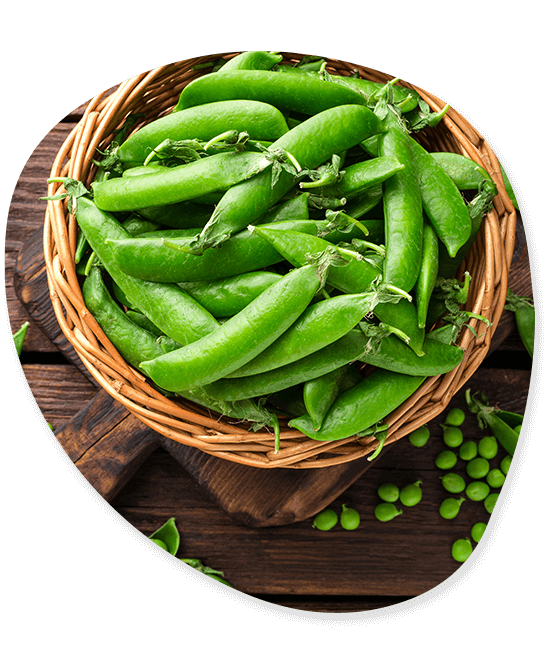Peas
The pea exporter in India must raise exports in accordance with the increased demand for peas around the world. Peas are nutritious and frequently utilised in different cuisines, which has led to an increase in pea export from India. Fresh or frozen peas are both acceptable forms for export. Both of these pea types are exported by the Indian pea exporter. There are other additional pea kinds that India exports in addition to these.

Nutrients:
- Calories – 62 calories
- Carbs- 11g
- Fiber- 4g
Minerals :
Vitamins:
Pre-Shipment Inspection:
Standard Packing:
PEAS VARIETIES WE EXPORT
Asauji, Arkel, Little Marvel, and other types of peas are among the peas imported from India. All of these types are premium-quality exports that are both fresh. The following cultivars of pea are exported.

ASAUJI
Peas with smooth, green, and dwarf seeds are known as asauji. This cultivar produces single pods. After sowing, the blossoming happens 30 to 35 days later. This particular pea type has narrow, curving, dark green pods that are around 8 cm long. When completely grown, these peas have seven seeds and have a spherical appearance.

ARKEL
The Arkel pea variety is a rare selection from France. The plant is a dwarf, although it grows quickly and can reach a height of 45 cm. Arkel’s white flowers are borne in pairs on a few lower nodes. The 8.5 cm long, dark green pods have wrinkled seeds and are incised toward the sutures. This type is appropriate for dehydration as well as the fresh market.

LITTLE MARVEL
A small plant from England called Little Marvel has wrinkled seeds. The pods are a dark green tint like the leaf. 40 days after seeding, the first blossom occurs at the 9th or 10th node. The 8 cm long, thick, lustrous, single-borne pods with 5–6 extremely tasty seeds inside.

JAWAHAR MATAR
Through selections after the T19 x Early Badger hybridization, the Jawahar Matar variation was created in Jabalpur. The plant grows to a height of 70–75 cm and has a bushy growth pattern. The pods have 4-5 wrinkly seeds and are roundish-oval in shape with a pale green tint. It is possible to begin the first picking 50 to 55 days after seeding.

HARBHAJAN (EC 33866)
Peas of the Harbhajan kind were created in Jabalpur through selection from a rare genetic background. First picking can be done 45 days after sowing because it is an early variety. These peas have tiny, yellow, rounded, and tiny seed pods. This variety produces 3 t/ha worth of pods on average.

BONNEVILLE
In the USA, the Bonneville variant was introduced. One of the most widely used kind of peas is this one. The plant grows to a medium height, and the majority of the flowers are doubles. The 6-7 well-filled, delicious, angular, and wrinkled seeds are contained in light green, straight, large pods. The initial flowering takes about 65 to 70 days after planting, and powdery mildew disease can affect it.

LINCON
The lincon variety’s plants grow to a medium height. It typically has two pods, which are dark green, curved, and large with eight to nine wrinkled seeds each. The first harvesting of this type may begin 85 to 90 days following sowing. For this particular cultivar, the typical pod yield is roughly 10t/ha.

PUNJAB 88 (P-88)
Peas of the Punjab 88 variety were selected at Ludhiana from the hybrid offspring of the Pusa02 Morriss-55 cross. This variety produces small, robust, upright plants with dark green foliage. After 100 days of seeding, the first picking for this variant may be carried out. The 7-8 green, wrinkled, and less sweet seeds are contained in long, dark-green pods that are somewhat bent at the centre.

AZAD P-2
Using superior generation selection, Kalyanpur scientists created the powdery mildew-resistant Azad P-2 variety from the Bonneville x 6587 cross. This variety’s plants are tall and upright, with light green leaves and white flowers. Azad P-2’s pods are medium in size, light green, straight, smooth, and solid. They are produced in a cluster of two and contain 6-7 wrinkly, brownish-colored seeds.

OOTY-1
Pure line selection was used at Udhagamandalam to create the Ooty-1 from PS 33. This plant is a dwarf variety with an 11.9 t/ha output potential over a 90-day crop period. The Ooty-1 can withstand whiteflies.
